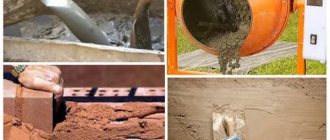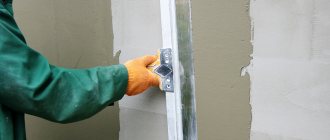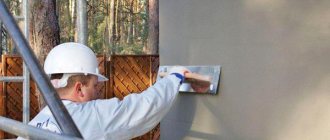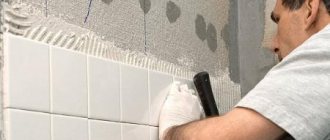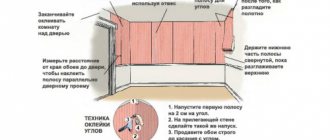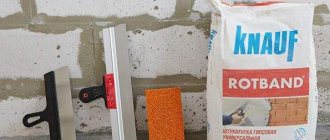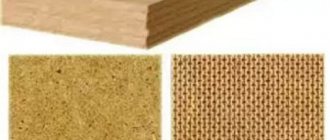Many people use this mixture to speed up the work process, but this is not correct. When cement is added to gypsum plaster, it begins to dry faster, which speeds up the work. But after applying plaster to the walls, after a few days it begins to crack, small cracks form, which is not acceptable for high-quality work.
If you add another layer on top of such plaster, the cracks will become even larger and then you will have to start all over again. If you mix gypsum plaster with cement, you will eventually have to clean the walls and apply a new layer of one material. It is best to perform gypsum plaster separately and cement-based plaster separately. In this case, the plaster will last longer than if the solution is diluted. To improve the quality of the composition, you can resort to special additives to gypsum plasters:
- special plasticizers;
- anti-adhesive agents;
- primers, etc.
I can answer this question unequivocally; it is impossible to add gypsum to cement mortar, even in small quantities. Although they say that when producing cement into clinker, this is an intermediate product, a small amount of gypsum is added, one or two percent, but I’m not strong in chemistry, I don’t know. But I have extensive experience in plastering with cement-sand mortar with the addition of gypsum.
I even had to work for such unscrupulous foremen who, apart from this “sinister mixture,” did not work with anything else. Why is this necessary? The speed of work increases five to ten times, and as you know, the faster you hand over an object, the faster you receive money. And don’t think that only small private owners are guilty of this.
The plaster layer made with a cement-gypsum mixture after some time of one to five days, depending on the base, begins to become covered with a web of very small cracks, they can be noticed if the surface is well primed with a primer.
You can putty and forget only if the base is made of red brick and the plastering work was carried out indoors. But in most cases, gypsum is added to cement when plastering concrete bases; on red brick, plaster sets quite quickly even without gypsum.
Preparing poison at home
Experts recommend buying ready-made poison for rats, for example, such as “Nutcracker”, “Tsunami”, “Storm” and many others. But "Ratindal" must be used with great caution. Although this is a very strong and effective drug, it is highly toxic and can cause great harm to the body.
However, it is not always possible to purchase a ready-made anti-rodent product.
To get rid of rats, you can prepare your own poison using available materials. There are many recipes for making a poisonous mixture with your own hands. But we must take into account that the animals have developed intelligence and an instinct for self-preservation . If there is food that is suspicious (for example, homemade poison to kill rodents), rats will most likely send one of their comrades. While he tries a small piece, others will watch him. And only if the animal remains alive and the food turns out to be harmless will others begin to eat.
Let's decide how to make your own deadly poison for rats.
From natural materials
A textured leaf (such as burdock) printed on cement can make a beautiful birdbath. To make such a decorative product, you need to pour a mound of wet sand onto a flat surface, cover it with polyethylene and place the selected sheet with the textured veins facing up.
Then spread a layer of cement mixture no thicker than two centimeters (reduce the thickness slightly towards the edges). Let's prepare the base - a piece of plastic pipe filled with concrete. Let's insert it in the center. After two days the leaf is ready. Let's paint it.
You can also make so-called “living” sculptures, inside which lawn grass will be placed. Or other plants.
To do this, you need to prepare a metal frame of the desired configuration, covered with wire. It is covered with a metal or polypropylene mesh, then soil is poured (where living plants will be planted), after laying a layer of straw.
Plaster mortar: composition of the plaster mixture
Solution preparation table.
The solution for plastering walls is made based on the following components:
- water;
- binding components - cement, clay, gypsum, lime;
- fillers - slag, sand, sawdust, shavings;
- cement is considered the strongest binder. The stronger the cement, the higher its grade. To prepare the plaster, cement grade M400 is used. The material hardens in both water and air. The setting process begins 15 minutes after mixing with water and ends after 12 hours. Cures and gains maximum strength within 28 days;
- Construction lime comes in several varieties: quicklime (“kipelka”), slaked (“fluff”), and ground. Hardens in air. The mixture is prepared only from slaked lime;
- clay serves as a binder and is used for plastering wooden walls and stoves;
- building gypsum is used as an additive to lime mortar. It increases the strength of the mixture and the speed of setting. The setting process begins within 4 minutes after adding water, and after half an hour complete hardening occurs.
The required strength of a plaster mortar consisting only of binder components and not containing aggregates cannot be achieved.
The most common filler is different types of sand. The highest quality, which is more suitable for plaster, is considered to be river quartz sand. Gully and mountain fill often contain clay impurities. For plastering work, medium-fraction sand is usually used.
How to dilute plaster or alabaster to fill a topiary pot
Complex design structures are made from this material. To fill any form, use a solution with a ratio of 7 to 10 gypsum and water, respectively. This consistency perfectly penetrates even the smallest cracks in the stone. To prevent the product from being too fragile, it is treated with glue.
IMPORTANT. For different types of work, different concentrations of the solution are used. Therefore, options for diluting gypsum should be studied in detail. It's better to consult a specialist.
How long does it take for alabaster to dry?
Alabaster is an analogue of gypsum, which is a grayish powder with a fine structure. It is obtained by heat treatment of gypsum dihydrate. Externally, gypsum and alabaster are practically indistinguishable. But the technical characteristics of these materials have the following differences from each other:
- setting of the alabaster solution occurs instantly after mixing, so its use is possible only if special additives are added to the solution to delay its drying;
- alabaster is a harder material than gypsum. This can be understood even by touch, by touching products made from these materials;
- using gypsum is safer for health than using alabaster.
How long does it take alabaster to dry? You can answer this question by knowing the technical characteristics of the dry alabaster mixture. The setting of the mixed alabaster solution begins 6 minutes after its preparation. The solution finally sets after half an hour. A couple of hours after dilution, dried alabaster can withstand a load of 5 Megapascals.
Complete drying of alabaster occurs within 1 - 2 days.
So, now you know how to dilute plaster, how to make it colored, how long it will take for it to dry completely and other aspects of working with this material. Next, it's up to you. Show yourself creatively and don’t limit your imagination, then you can create many interesting and exclusive plaster crafts that will perfectly decorate your home or garden!
You need a mold and a solution of plaster and water. But many do not know how to properly dilute plaster with water so that it is convenient to work with the mixture. The quality of the stone also directly depends on the correctly diluted solution.
Technology for manufacturing artificial stone from gypsum
First you need to create a silicone mold for the stone.
Helpful Tips:
- The proportions are determined independently. Depending on the complexity of the form. The more complex the shape, the more liquid the mass should be.
- The solution is applied. You need to stir thoroughly so that there are no islands of dry powder. The final appearance is a homogeneous mass.
- To make the material strong, you need to add sand to it. Approximately 10-15% of the total mass of the solution.
- The molds are lubricated with wax. This is necessary to remove the product without difficulty.
- To make everything quick, you need to roughly calculate the amount of mass to fill all the molds.
- When dry, dimples may form. To avoid this, products are laid on a special surface. When they form, they are added with a liquid solution.
- To obtain a stone of a certain color, special dyes are added to the solution.
- After filling the molds, it is necessary to create vibrations. They will help distribute the liquid evenly among the molds. And it will eliminate the formation of air bubbles, which will contribute to the destruction of the stone.
- After pouring, the surface is leveled with a special tool.
- Hardens in approximately 30 minutes. At this time, the forms should not be touched to prevent voids from forming.
IMPORTANT. To dilute the solution, it is best to take a disposable container. The hardened mixture is very difficult to clean.
Possible problems when using metakaolin
Previously, it was pointed out that an overdose of microsilica is inadmissible. The same applies to metakaolin.
Here are some recommendations from the developer of the VMC when using it as part of the GCPV.
To reliably prevent the uncontrolled formation of ettringite in HCPV compositions, it is sufficient to add 10% metakaolin to Portland cement.
This leads to a dosage of IUDs of only 1-2% of the composition.
Just like microsilica, VMK is a finely dispersed powder. It is prone to flocculation and requires the mandatory introduction of an effective dispersant (plasticizer).
Thorough mixing of the solution is also necessary.
Despite many recommendations to administer IUD in amounts up to 20%, experience has shown that an overdose can adversely affect the strength of the stone.
This is due to two reasons:
- If there is a lack of lime and other materials with which the VMC could react, it becomes an inert filler.
- High dosages of VMC significantly change the granulometry of the entire composition.
Source
Is it possible to apply a cement mixture over the gypsum-based mixture for rough leveling?
Please tell me, is it possible to apply a cement mixture over the gypsum-based mixture for rough leveling?
comment to favorites Kongl amera ntus [51.3K] 7 years ago
It is possible, since a properly prepared cement mortar applied to the surface in good condition (if the gypsum does not fall off) will adhere well, since the cement has high qualities in terms of strength and adhesion to the surface.
Everything, of course, will depend on the thickness of the required layer, since it should be taken into account that gypsum-based mixtures are somewhat softer, and with a large layer, additional reinforcement of the wall with mesh may be required.
In addition, I would like to suggest that you use starting putty for leveling. Unlike the finishing one, the starting one is designed specifically for leveling surfaces. True, here too everything depends on the thickness of the layer.
Another interesting thing is what will happen to this wall later? If, for example, it is a tile, and the wall is in a damp room, then it is not a fact that such a wall will be reliable. It is necessary to make high-quality waterproofing.
Ettringite or "cement bacillus"
Is it possible to mix gypsum with cement to obtain a universal solution that can be applied in a thick layer and allows you to level a surface with noticeable defects in one go? Despite the fact that this approach is practiced by unscrupulous private craftsmen, adding gypsum or alabaster to the cement-sand mixture is strictly not recommended.
The aluminate components of cement react with gypsum when mixed with water, resulting in the formation of calcium hydrosulfoaluminate - ettringite. In ancient times, the appearance of ettringite was called “cement bacillus” - as the crystals gain strength, they greatly increase in volume and destroy the cement stone; it is impossible to resist this process.
Hydration (addition of water molecules) occurs not only during the preparation of the solution, but also under the influence of moisture on the material - for example, if the walls are plastered with a cement-gypsum mixture in a room with a high level of humidity or in the open air.
